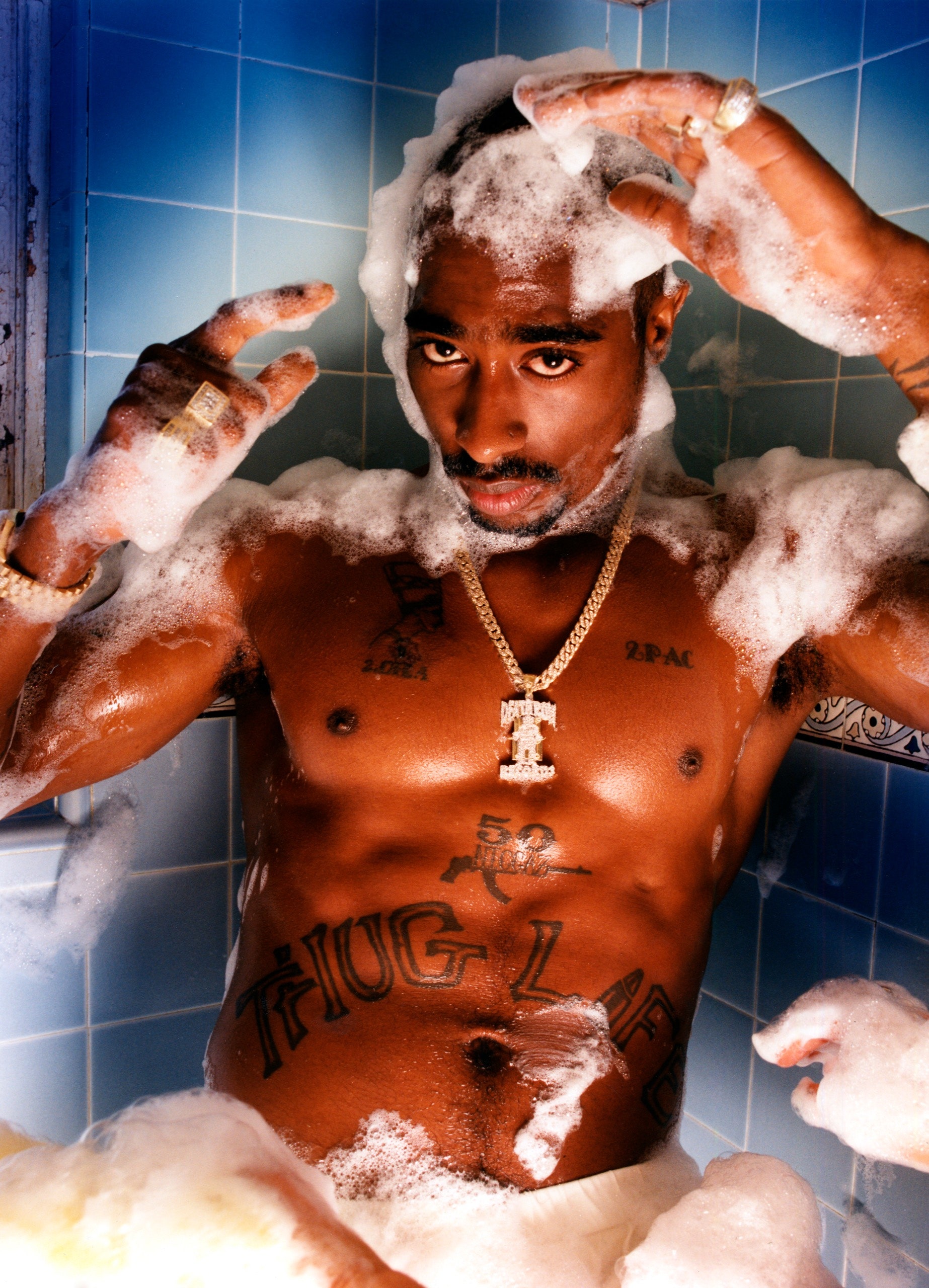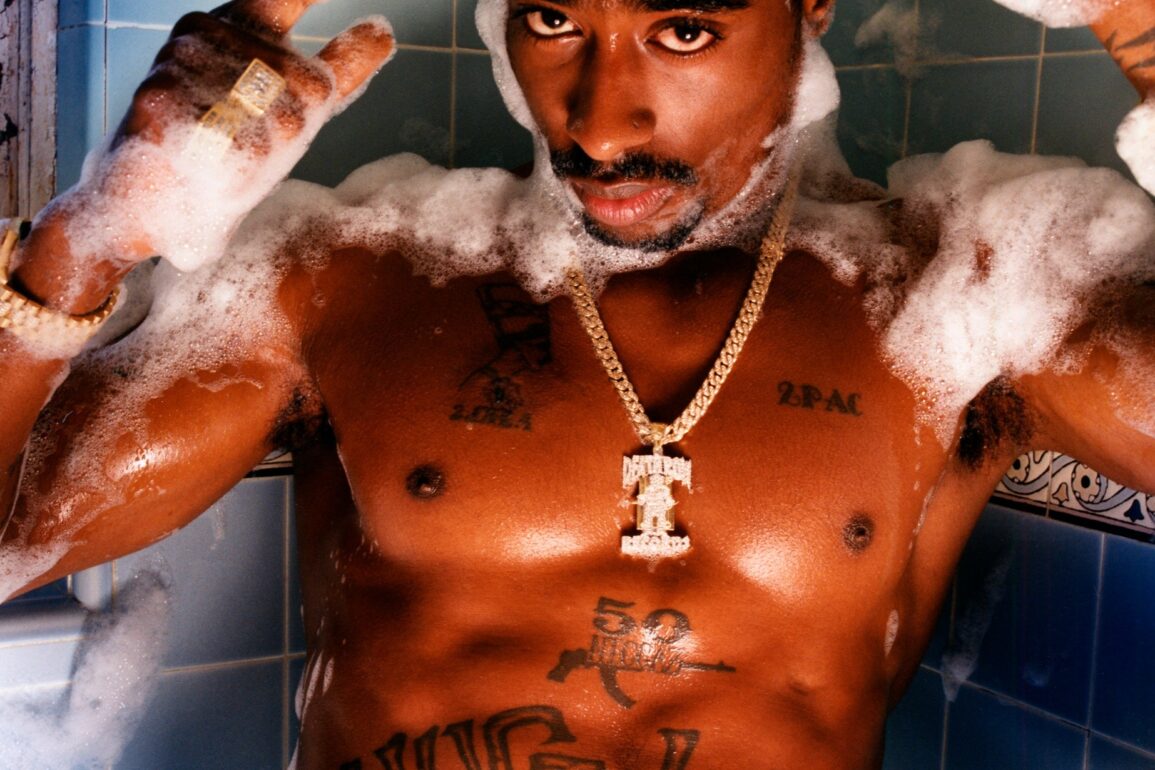Why Tupac Never Died

In just five years of stardom, Tupac Shakur released four albums, three of which were certified platinum, and acted in six films. He was the first rapper to release two No. 1 albums in the same year, and the first to release a No. 1 album while incarcerated. But his impact on American culture in the nineteen-nineties is explained less by sales than by the fierce devotion that he inspired. He was a folk hero, born into a family of Black radicals, before becoming the type of controversy-clouded celebrity on the lips of politicians and gossip columnists alike. He was a new kind of sex symbol, bringing together tenderness and bruising might, those delicate eyelashes and the “fuck the world” tattoo on his upper back. He was the reason a generation took to pairing bandannas with Versace. He is also believed to have been the first artist to go straight from prison, where he was serving time on a sexual-abuse charge, to the recording booth and to the top of the charts.
“I give a holla to my sisters on welfare / Tupac cares, if don’t nobody else care,” he rapped on his track “Keep Ya Head Up,” from 1993, one of his earliest hits, with the easy swagger of someone convinced of his own righteousness. On weepy singles like “Brenda’s Got a Baby” (1991) and “Dear Mama” (1995), he was an earnest do-gooder, standing with women against misogyny. Yet he was just as believable making anthems animated by spite, including “Hit ’Em Up” and “Against All Odds”—both songs that Shakur recorded in the last year of his life, with a menacing edge to his voice as he calls out his enemies by name. That he contained such wild contradictions somehow seemed to attest to his authenticity, his greatest trait as an artist.
He died at the age of twenty-five, following a drive-by shooting in Las Vegas, in 1996. Until last month, nobody had been charged in the murder, despite multiple eyewitnesses—a generation’s initiation into the world of conspiracy theories. An entire cottage industry arose to exalt him. Eight platinum albums were released posthumously. His mystique spawned movies, museum exhibitions, academic conferences, books; one volume reprinted flirtatious, occasionally erotic letters he’d mailed to a woman while incarcerated. There appears to be no end to the content that he left behind, and it has been easy to make him seem prophetic: here’s a clip of him foretelling Black Lives Matter, and here’s one warning of Donald Trump’s greed. Every new era gets to ask what might have happened had Shakur survived.
Read our reviews of notable new fiction and nonfiction, updated every Wednesday.
This plenitude is the challenge faced by “Tupac Shakur: The Authorized Biography” (Crown), a book that the novelist and screenwriter Staci Robinson began working on nearly a quarter century ago. She first met Shakur, who attended the same Bay Area high school that she had, when he was seventeen. In the late nineties, at his mother’s behest, Robinson began interviewing his friends and family, though the project was soon put on hold. She was asked to return to it a few years ago, and was given access to unpublished materials.
It’s a reverential and exhaustive telling of Shakur’s story, leaning heavily on the perspective of his immediate family, featuring pages reproduced from the notebooks he kept in his teens and twenties. The biography’s publication follows “Dear Mama: The Saga of Afeni and Tupac Shakur,” a documentary series that premièred, on FX, in April. Robinson was an executive producer on “Dear Mama,” which drew on the same archive of estate-approved, previously unreleased materials as her book, and the works share a common purpose: to complicate Shakur without demystifying him.
She begins, as the artist himself would have preferred it, with his mother. Afeni Shakur was born Alice Faye Williams on January 10, 1947, in Lumberton, North Carolina; about twelve years later she moved to the South Bronx. Williams was academically gifted and attended the High School of Performing Arts, in Manhattan, though she felt out of place among her more affluent classmates and eventually dropped out. In the late sixties, she became interested in Black history and Afrocentric thinking, took the Yoruba name Afeni, and joined a local chapter of the Black Panthers. In 1968, she married Lumumba Shakur—and into a family of political radicals. His father, Salahdeen Shakur, was a revolutionary leader who’d worked closely with Malcolm X. The Shakurs were such a force that others in their circle adopted their surname as a mark of allegiance.
In April, 1969, prosecutors charged her and twenty other Black Panthers with participating in a plot to kill policemen and to bomb police stations and other public places throughout the city. The police relied on undercover informants, one of whom Afeni had long suspected. As Robinson writes, this “was the beginning of what would become a lifelong ‘trust nobody’ mentality.”
The defendants became known as the Panther 21. Supporters raised enough money to get Afeni out on bail. “Because I was articulate, they felt that I would be able to help get them out if I got out first,” she recalled. When the case went to trial, in 1970, Afeni, who was pregnant, defended herself and supported her comrades from the stand. She was clever, charismatic, and relentless in the courtroom, helping her fellow-Panthers gain acquittal in May, 1971. The journalist Murray Kempton, who covered the trial, wrote that Afeni spoke “as though she were bearing a prince.”
Her “trust nobody” mentality was encoded into Tupac Shakur’s very identity. He was born Lesane Parish Crooks in East Harlem in June, 1971, and Robinson explains that the name, borrowed from Afeni’s cellmate, Carol Crooks, was meant to protect him from being seen as a “Panther baby.” Meanwhile, Afeni’s marriage collapsed when Lumumba learned that she had been seeing other men; Tupac’s biological father, whose identity would remain a mystery for years, was a man named Billy Garland.
From the beginning, Afeni saw her son—whom she would rename Tupac Amaru, for the Peruvian revolutionary—as a “soldier in exile.” Robinson depicts her as a devoted, and at times demanding, mother. She enrolled him at a progressive preschool in Greenwich Village—but withdrew him after she came to pick him up and saw him standing on a table and dancing like James Brown. “Education is what my son is here for, not to entertain you all,” she told his teacher. Later that night, as she spanked her son, she reminded him, “You are an independent Black man, Tupac.”
In 1975, Afeni married an adopted member of the Shakur clan, the revolutionary Mutulu Shakur, with whom she had a daughter, Sekyiwa. Despite gestures toward a conventional life, Afeni couldn’t shake her experiences in the sixties, especially her sense of mistrust and vulnerability. She split from Mutulu in the early eighties and moved with Tupac and Sekyiwa to Baltimore, where she struggled with addiction and a larger sense of disillusionment. “It was a war and we lost,” she later explained. “Your side lost means that your point lost. . . . That the point that won was that other point.”
Shakur sometimes felt that his mother “cared about ‘the’ people more than ‘her’ people.” He attended the Baltimore School for the Arts, with the hope of becoming an actor, and fell in with an artsy crowd that included Jada Pinkett. Robinson sees this as a period of self-discovery. He was into poetry and wore black nail polish, recruited classmates for the local chapter of the Young Communist League, and obsessively listened to Don McLean’s “Vincent,” a feathery tribute to the misunderstood genius of van Gogh, who had “suffered” for his sanity: “This world was never meant for one / As beautiful as you.”
Just before his senior year of high school, Tupac and Afeni moved to California, where they would be closer to Sekyiwa, who had gone to live with family friends just north of San Francisco. “He taught us a lot about Malcolm X and Mandela,” a local d.j. recalled, “and we taught him a lot about the streets.” Shakur eventually befriended members of Digital Underground, an Oakland hip-hop group that took inspiration from the energy and the eclecticism of seventies funk. He worked primarily as a dancer before earning a guest verse on Digital Underground’s 1991 hit “Same Song.”
In the early nineties, making it through hip-hop’s hypercompetitive gantlet didn’t guarantee stability. Robinson writes that Shakur considered leaving music for a career in political organizing. His modest, local fame got him a record deal, but it didn’t insulate him from the troubles facing most young Black males. In October, 1991, he was stopped by the police for jaywalking in downtown Oakland. After a brief argument, in which the officers made light of his name, the rapper was put in a choke hold, slammed against the pavement, and then charged with resisting arrest. (He sued the city of Oakland, settling out of court.)
That November, he released his début album, “2Pacalypse Now,” drawing on the slow-rolling, synthesizer-driven funk of the West Coast. His political convictions gave shape to his anger; there was a brightness to his voice which made tales of police brutality, such as “Trapped” (“too many brothers daily headed for the big pen”), seem like an opportunity to organize, not a reason for resignation. “2Pacalypse Now” gained notoriety when Vice-President Dan Quayle demanded that the rapper’s record label recall it, after a self-professed Tupac fan shot a state trooper in Texas. Among aficionados, meanwhile, Shakur became better known for “Brenda’s Got a Baby,” which he wrote after reading a newspaper story about a twelve-year-old Black girl who put her newborn down a trash chute. Shakur avoids judgment, instead pointing to larger forces at play: “It’s sad, ’cause I bet Brenda doesn’t even know / Just ’cause you’re in the ghetto doesn’t mean you / Can’t grow.”
At the heart of the Tupac Shakur mythology is how much of his artistic persona was the result of moments in which he imagined what it might be like to walk in another’s shoes. It speaks to how empathetic—but also how impressionable—he could be. It’s something his fans often debate: Were there simply some poses he could never shake? While working on what became his début album, he had been filming “Juice,” Ernest Dickerson’s movie about four young men juggling friendship and street ambition in Harlem. He played Roland Bishop, whose devil-may-care drive distinguishes him from his pals, and leads him to betray them. Shakur studied Method acting while in high school, and some believe Bishop was the beginning of a series of more sinister characters that Shakur absorbed into his persona.
There are a few clips on YouTube of speeches that Shakur delivered in the early nineties, and they are among the most riveting performances he ever gave. In one, he addresses the Malcolm X Grassroots Movement at a banquet in Atlanta. Shakur, introduced as a “second-generation revolutionary,” regards the room of middle-aged activists, some of whom might have fought alongside his mother, with a punk irreverence. “It’s on, just like it was on when you was young,” he says, casting himself as the new face of the struggle. “How come now that I’m twenty years old, ready to start some shit up, everybody telling me to calm down?” He keeps apologizing for cursing before cursing some more, making light of their respectability politics. “We coming up in a totally different world. . . . This is not the sixties.”
He talked about an initiative called 50 N.I.G.G.A.Z.—a backronym for “Never Ignorant, Getting Goals Accomplished”—in which he would recruit one young Black man in each state to build a community-organizing network. This eventually became T.H.U.G. L.I.F.E. (“The Hate U Gave Little Infants Fuck Everybody”). The approach was inspired by the Black Panthers and sought to mend the divisions engendered by gang life. By the time he released his triumphant 1993 album, “Strictly 4 My N.I.G.G.A.Z.,” he seemed resolute in his pursuit of politics by other means.
That fall, he went to New York to film “Above the Rim,” the story of a talented basketball player trying to steer clear of a local drug dealer who has taken an interest in his success. Shakur was the villain, and to shape the role he spent time with Jacques (Haitian Jack) Agnant, a local gangster. Agnant was present on a night that became pivotal to Shakur’s life. That November, Shakur, Agnant, and two others were accused of sexual assault by a woman the rapper had met a few days earlier at a club. Shakur claimed to have fallen asleep in an adjoining room, and to have played no role in the alleged abuse.
“When the charge first came up,” he explained in an interview for Vibe magazine, “I hated black women. I felt like I put my life on the line. At the time I made ‘Keep Ya Head Up,’ nobody had no songs about black women. I put out ‘Keep Ya Head Up’ from the bottom of my heart. It was real, and they didn’t defend it. I felt like it should have been women all over the country talking about, ‘Tupac couldn’t have did that.’ ”
This is a challenging moment to weave into a largely flattering biography. Biographies tend to make a life into a series of inevitable outcomes. At times, Robinson’s book invests more in exhaustive detail than in a sense of interiority. We get the family and friends lobbying on Shakur’s behalf. “He was not just angry, but insulted by the charge,” his aunt explains to Robinson. The author continues, “Afeni felt sympathy for the woman, but she never doubted that Tupac was innocent.” (Robinson notes that his accuser “would tell a different story.”)
A song like “Wonda Why They Call U Bitch” (addressed to a “sleazy,” “easy” gold-digger) might be rationalized as so much toxic bravado. It’s much harder to explain away acts of coercion. Fans and journalists struggled with this question at the time. In June, 1995, Vibe printed a letter from his accuser. She denied that Shakur was, as he insisted, in an adjoining room. “I admit I did not make the wisest decisions,” she writes, “but I did not deserve to be gang raped.”
The episode marked the beginning of Shakur’s paranoid descent. In late November, 1994, almost exactly one year later, he was beaten up and robbed in the lobby of a recording studio in New York. During the scuffle, he was shot five times. The following day, he was found guilty of first-degree sexual abuse, a lesser charge among those he faced, but one that still carried a sentence of eighteen months to four and a half years in prison. “It was her who sodomized me,” he declared of his accuser at the time of the trial. (Agnant pleaded guilty to misdemeanor charges and got probation.) A person of extremes, he expected extremes of those around him. “He definitely believed there were two kinds of women,” Jada Pinkett Smith told Michael Eric Dyson, whose 2001 book, “Holler if You Hear Me: Searching for Tupac Shakur,” helped bring Shakur to the academy. “He had a way of putting you on a pedestal and, if there was one thing you did wrong, he would swear you were the devil.”
Shakur was sentenced in February, 1995. He became convinced that Christopher Wallace (better known as the Notorious B.I.G.) and Sean Combs (then Puffy), who were at the studio the night he was shot, were part of a setup; he thought Agnant was in on it, too. (All three denied involvement.) In the meantime, his legal bills had left him with precarious finances. Suge Knight, the bullying head of Death Row Records, a label with ties to L.A.’s gang underworld, persuaded Shakur to sign with him; soon afterward, its parent label posted bail, so that Shakur could go free while he appealed his conviction. Knight preyed on Shakur’s growing persecution complex. By this time, it was hard to recall that his famous “THUG LIFE” tattoo, which was inked across his abdomen in 1992, had once held a political meaning. The struggle was no longer against an unjust establishment; it was between “ridaz and punks,” his fast-living crew and its “bitch” rivals.
He was feverishly productive, sometimes setting up two studios at once and bouncing between them, working on different songs at the same time. Months after his release, Shakur put out a double CD—the first by a solo rapper—called “All Eyez on Me.” Joining Death Row gave his music a fearless and foreboding feel; it sounded both harder and more radio-ready than anything he’d previously done, his raps toggling from hell-raising party boasts to taunting sing-alongs. But there were also moments of penitence, like “Life Goes On” and “I Ain’t Mad at Cha,” which some fans later interpreted as prophecies of his demise.
In the ten months following his release, he recorded two additional albums and worked on two films. He had plans for restaurants, a fashion line, a video game, a publishing company, a cookbook, a cartoon series, and a radio show. In her introduction, Robinson explains that Shakur had couch-surfed at her apartment when he was younger and visiting Los Angeles to meet with record labels. He never forgot her kindness. He told her that he was forming a group of women writers to work on screenplays with him. Their first meeting was to be at his Los Angeles condo on September 10, 1996.
The writers’ group would never meet. On September 7, 1996, Shakur attended a Mike Tyson fight in Las Vegas. Afterward, he caught four bullets from a drive-by near the Strip. His death, six days later, mired in mystery, seemed instantly significant. Chuck D, of Public Enemy, soon floated a theory that the rapper was still alive. When Shakur’s first posthumous album was released, in November, fans combed it for clues that he had faked his own death.
Others tried to reconcile the vengeance rap he recorded for Death Row with the conscious ideals with which he’d started out. “It is our duty to claim, celebrate and most of all critique the life of Tupac Shakur,” Kierna Mayo wrote a few months after his demise. In 1997, Vibe published a book collecting its coverage of the artist. “Wasn’t Tupac great when he wasn’t getting shot up? Or accused of rape?” the editor Danyel Smith asks in the introduction. “Wasn’t he just the best when he wasn’t falling for Suge Knight’s lame-ass lines and dying broke? Couldn’t Tupac just have been your everything?” In the Village Voice,the critic dream hampton wrote, “I believed he’d get his shit together and articulate nationalism for our generation.”
For years, the most plausible explanation for Shakur’s murder was that he fell victim to a feud between two Los Angeles gangs, the Mob Piru Bloods, with which Death Row was associated, and the South Side Compton Crips. In 2019, a Crips leader, Duane (Keffe D) Davis, published “Compton Street Legend,” in which he detailed the mounting tensions that led to Shakur’s killing. “Tupac was a guppy that got swallowed up by some ferocious sharks,” Davis wrote. “He shouldn’t have ever got involved in that bullshit of trying to be a thug.” Davis explained that, although he didn’t pull the trigger, he was in the car and supplied the murder weapon. In September of this year, he was finally arrested by the Las Vegas Police Department, and he now faces murder charges. (A former lawyer of his told the New York Times that Davis plans to plead not guilty.)
Rap music has a particular relationship with death—a reminder of the precariousness of Black life. In a recent essay on hip-hop’s long trail of deceased, Danyel Smith lamented that “so much of Black journalism is obituary.” The one-two punch of Shakur’s death in September, 1996, and the Notorious B.I.G.’s the following March taught a generation how to mourn: loudly, defiantly. Perhaps Shakur’s contradictions—the gangster poet who was never exactly a gangster, the actor who could never break character—would have found resolution had he lived longer. At the heart of things was always the question of how to distinguish the persona from the person.
That Shakur left so much behind—a vault of unreleased songs, a startling trove of videotaped interviews, from his high-school years to the last hours of his life, the speeches and performances—is one reason that his career can appear to be a solvable mystery. He could have been a political leader or gone on to even greater success as an actor or a recording artist. What he wanted, however, seemed always to elude him. I remember seeing the February, 1994, issue of Vibe, which featured Shakur in a straitjacket, and the question “Is Tupac crazy or just misunderstood?” Maybe a little of both? He took on the world because he was young, convinced that he could turn the pain around him into something else. He trusted nobody; he wished to love everybody. He was, for a long cultural moment, incandescent. But he was never free. ♦










